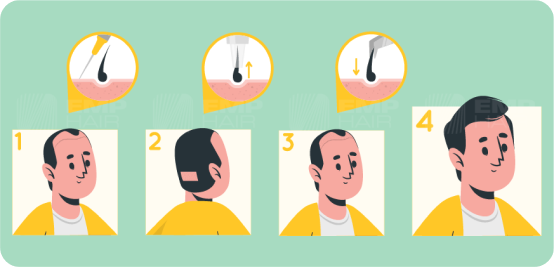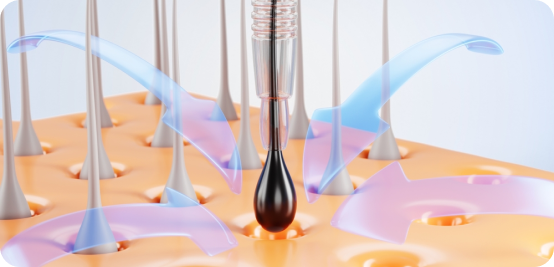
Hair that becomes thinner, falls out or disappears completely over time is not only an aesthetic problem. It can deeply affect one's psychology, self-confidence and even social life. However, with today's technology, hair loss is no longer a fate. Hair transplantation is a powerful solution that restores not only your hair but also your quality of life.
Table of Contents
What is FUE Hair Transplantation?
Hair transplantation is the transplantation of healthy hair follicles that are resistant to hair loss, usually in the nape of the neck, to balding or sparse areas. FUE, DHI and Long Hair FUE Hair Transplant procedures performed with advanced techniques offer natural, scarless and permanent results. Each individual's hair structure, hair loss type and expectations are different; therefore, hair transplantation is planned completely individually.

Who Can Have a Hair Transplant?
- Individuals with male pattern hair loss
- Local hair loss in women
- Regional hair loss after burns, trauma or surgical scars
- Those who want a more lush and aesthetic hair appearance
- Anyone with a sufficient density of hair follicles in the donor area

Which Methods Are Used? What are Hair Transplant Techniques?
Hair transplantation procedures can be applied with different techniques according to the needs and hair structure of the person. Among the most commonly used methods, FUE, DHI and Long Hair FUE Hair Transplantation stand out. Each method has different advantages, healing process and result quality. You can browse the related techniques to learn the most suitable hair transplant method for you:
DHI Hair Transplant
DHI hair transplantation with direct hair follicle placement (Choi Pen) method is applied without the channel opening stage. It offers more frequent and controlled transplantation. It is a preferred technique especially for individuals with thinning hair.
FUE Hair Transplantation
FUE is the most common and scar-free method in which hair follicles are taken one by one and transplanted with special micro-motors. It offers a natural look and a high success rate. The healing process is fast and comfortable.
Long Hair FUE Hair Transplant
In this method, the hair is transplanted without cutting the hair, especially suitable for women or men who do not want to cut their hair. It is possible to return to daily life immediately afterwards. It provides aesthetic gain without visual change.
Hair Transplant for Women
It is planned by taking into consideration the types of hair loss specific to women. It offers effective solutions for the recovery of the front hairline and localized hair loss. It is a method that restores self-confidence for women with thinning hair.
Stem Cell Assisted Hair Transplantation
It is supported by stem cell therapy for the hair follicles to hold stronger and accelerate the healing process. It improves hair quality and increases the success rate after transplantation. It is an innovative and effective approach.
Needle Free Hair Transplant (Painless)
Anesthesia is applied with compressed air technology instead of classical injections. It has been specially developed for individuals with low pain threshold. It offers a comfortable and painless hair transplant experience.
Hair Mesotherapy
Special vitamin and mineral cocktails are injected into the scalp to stop hair loss and nourish hair follicles. It can be applied alone or as a support after transplantation. It is a medical solution that strengthens and revitalizes the hair.

Hair Transplant Process
- Preliminary Interview and Analysis
Before the procedure, your hair structure, hair loss type and donor area density are analyzed by our experts. Personalized planning is made in line with the targeted appearance and needs. - Operation Day
Local anesthesia is applied.
Hair follicles (grafts) are taken one by one from the donor area.
Micro channels are opened in the areas to be transplanted.
The grafts are carefully placed in these channels.
This procedure usually takes 6 to 8 hours. You will be discharged on the same day after the procedure. - First 10 Days
This is the most important period of healing. Scabs start and fall off completely within 7-10 days. Hair follicles begin to settle. - Shock Shedding Period (1st month)
Transplanted hair will temporarily fall out. This is a natural and temporary process. It does not pose a problem as the roots are located under the skin. - Between 3-6 Months
New hair starts to grow. It has a sparse appearance, but the volume gradually increases. - Between 6-12 Months
Density and hair quality improves. 80-90% of the results become visible during this period.
Why Hair Transplant?
- Provides a Permanent and Natural Solution: Since the follicles used in hair transplantation are taken from the area resistant to hair loss, they are permanent for life. In addition, transplants made with modern techniques provide an extremely natural appearance.
- Regains Self-Confidence: Hair is very important not only for aesthetics but also for personal image. Having strong hair provides self-confidence in social and professional life.
- No Surgical Risk: It is performed with local anesthesia, hospitalization is not required. The healing process is fast, the risk of complications is very low.
- It is not only aesthetic but also a psychological recovery: Hair loss can make a person withdrawn over time. After hair transplantation, these people lead a more active, happier and more positive life.
- Your Own Hair, Your Own Touch: It is not a foreign substance or prosthesis; the procedure is performed with your own roots. There is no tissue rejection.
“I Thought I Was Losing Myself... Turns Out I Was Just Losing My Hair”
The End of the Inner War that Starts with Hair Loss: Possible with Hair Transplantation
“My hair is going... And I am slowly fading away with it.”
Hair loss doesn't start suddenly.
Quietly, imperceptibly... but effectively.
A few strands on the pillow in the morning, then tufts in the shower...
And then you see a different you in the mirror.
You look more tired to your eyes now.
You photograph yourself less.
There is always a state of “self-control” in the public transport window, in the
shopping, in the elevator...
Hair transplantation is the step that stops this inner loss.
It doesn't just give hair back.
It gives back control.
It creates a familiar shadow on your face again.
“I am a woman and I can't even talk about my hair loss."
Hair loss is still taboo for women.
Many women perceive hair loss as a deficiency, something to be ashamed of.
That's why most of the time she doesn't tell anyone, she struggles silently.
Wigs, sprays, attempts to cover it with a bun...
But now hair transplantation for women is also comfortable, unshaven, natural and
safe.
Before anyone knows it, you are reinventing yourself.
And in the morning you start to look in the mirror “without hiding”.
“I want to invest in myself, but I'm afraid that a hair transplant will look artificial.”
Naturalness is the biggest concern.
Questions such as “Will it be obvious that you had a hair transplant?”, “Will there be
stitch marks?”, “Will my hairline look fake?” are very discouraging, especially for
those who have seen failed examples before.
Thanks to modern hair transplantation techniques (FUE, DHI, Sapphire, stem cell
supported applications), transformation is now possible without compromising
naturalness.
The transplanted hair is placed directionally, at an angle, frequently and in accordance
with your facial line.
So there is no naturalness, only “balding” remains artificial.
Frequently Asked Questions
